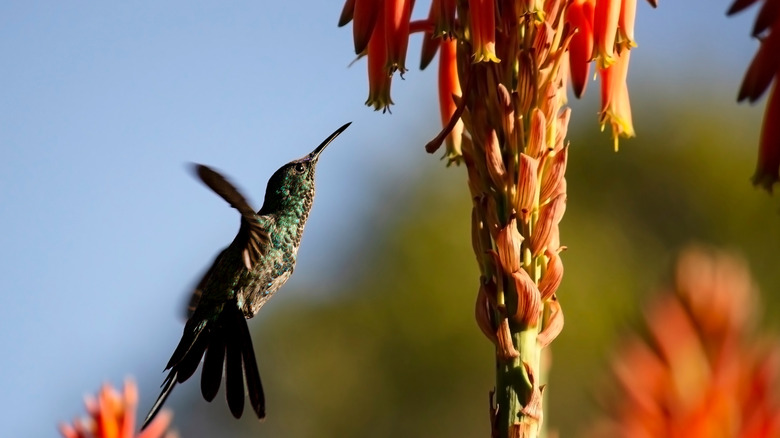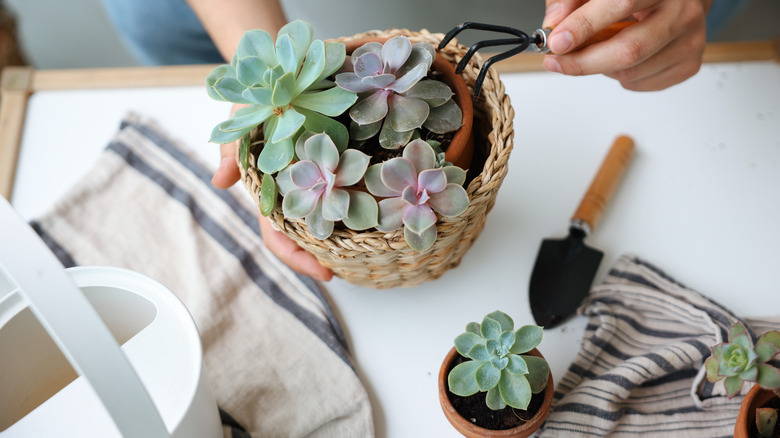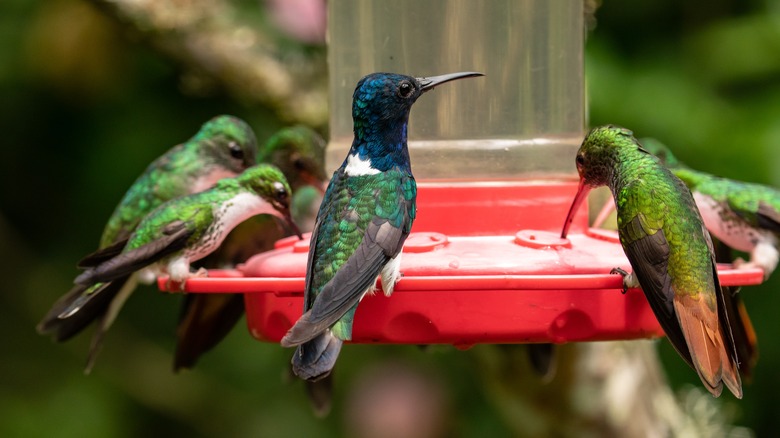Beautiful Succulents That Hummingbirds Can't Get Enough Of
We may receive a commission on purchases made from links.
Recognizable for their fleshy leaves and ability to store water, succulents are a diverse group of plants that are particularly well-suited to arid environments and low-maintenance gardening. These plants offer a myriad of benefits for gardeners, including drought tolerance, vibrant colors, and unique shapes and textures. Among the many species of succulents, echeveria, California fuchsia, and aloe vera stand out not only for their beauty but also for their ability to attract hummingbirds to the garden. Hummingbirds love the nectar-rich flowers of these succulents, which provide them with a valuable food source.
Echeveria's rosette-shaped leaves and colorful flowers are particularly attractive to hummingbirds, who will eagerly visit the blooms to feed on their sweet nectar. California fuchsia's tubular, red-orange flowers are a favorite of hummingbirds as well. Their vibrant color and the abundant nectar they provide never fail to draw the tiny birds. Besides helping to treat burns and soothe skin irritations, aloe vera is also a magnet for hummingbirds. Its tall spikes of tubular orange, red, yellow, or pink flowers that hang in clusters attract hummingbirds seeking nectar-rich blooms.
Having hummingbirds visit your garden is a delightful sight and beneficial for the ecosystem. Hummingbirds are important pollinators that help to facilitate the reproduction of many plant species, including succulents. By planting these succulents that hummingbirds love in your garden, you can create a welcoming habitat for these fascinating avians while enjoying the charm of their visits.
Growing succulents hummingbirds love
If you want to cultivate echeveria, California fuchsia, and aloe vera in your garden, it's crucial to observe general succulent care tips for successful planting. When it comes to their lighting needs, succulents can tolerate some direct sunlight. However, too much exposure can lead to sunburn or leaf damage. So, place them in a location that receives bright, indirect sunlight or partial shade. Use a well-draining potting mix enriched with organic materials like coco noir or pine bark and a mineral component (e.g., perlite, volcanic rock) for good drainage. It's important to use this type of soil specifically formulated for succulents and cacti as heavy, water-retentive soils can cause root rot. Allow the soil to dry out between waterings, and water the plants sparingly during the dormant winter months. Succulents prefer warm temperatures and can be damaged by frost. Protect them from freezing temperatures by bringing them indoors or providing protection like frost cloth. Remove dead or damaged leaves and flowers regularly to promote healthy growth.
Healthy succulents may not require fertilizing, especially if you repot them periodically. But if your plants are showing signs of weakness or deficiency (e.g., pale or yellowish leaves not due to overwatering), fertilize them with a succulent-specific product like Espoma Organic Cactus! Plant Food (8 oz; pack of three), which retails for $19.59 on Amazon, or Cute Farms Succulent, Cacti & Aloe Fertilizer (8 oz. spray bottle), priced at $10.95 when you purchase it online at Walmart.
Making your garden attractive to hummingbirds
In addition to planting these hummingbird-attracting succulents, there are other plant varieties you may want to consider growing for these cute little pollinators to enjoy, like columbine, penstemon, salvia, bee balm, honeysuckle, and daylilies. Some of these flowering plants attract hummingbirds, other pollinators like bees and butterflies, and other good garden bugs that prey on pests.
Giving hummingbirds easy access to water is another way of encouraging their visits. Install a birdbath or shallow water feature where the birds can drink and bathe. Hang hummingbird feeders filled with a sugar-water solution to supplement their natural diet. Provide hummingbird shelter and nesting sites like trees, shrubs, and dense vegetation. Consult your local gardening center to find out which flowering plants native to your area can attract hummingbirds. Growing local flora means you're also cultivating naturally resilient (being local) plants that can provide nourishment and shelter for friendly wildlife in your garden. By incorporating these elements into your garden landscape, you can create an attractive and inviting habitat for hummingbirds while enjoying the beauty of their visits to your garden.


